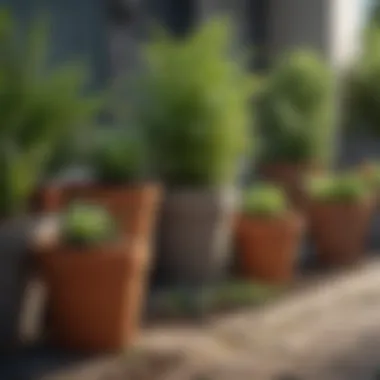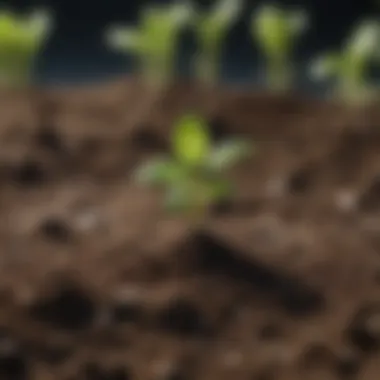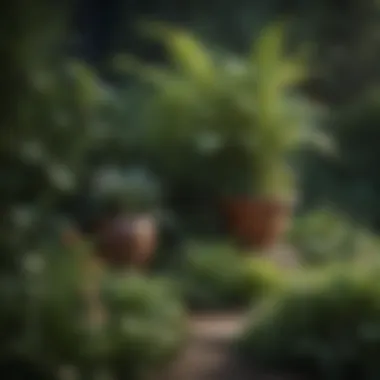Beginner-Friendly Garden Plants for All Environments


Intro
Starting a garden can be both exciting and daunting for novice gardeners. Selecting the right plants is key to ensuring a fruitful and enjoyable gardening experience. This article focuses on optimal starter garden plants that are versatile and can thrive in different environments. Understanding essential factors such as climate, soil type, and plant compatibility is crucial for planting success. This guidance will help in choosing plants that are not only easy to grow but also contribute to a sustainable gardening practice.
Design Inspiration
Trending Styles and Themes
Contemporary gardening trends emphasize minimalism and sustainability. For those looking to create a serene garden environment, consider plants that embody a natural aesthetic. Species like lavender and ornamental grasses can be stunning options. They often require less water and care, making them perfect for beginners.
The theme of biodiversity is gaining traction. Incorporating a variety of plants supports local wildlife, such as bees and butterflies, and enhances the garden's ecosystem. A mix of flowering plants, edibles like tomatoes, and herbs like basil can create a vibrant garden that's pleasing to the eye and beneficial for the environment.
Color Palettes and Combinations
When choosing plants for your starter garden, consider their colors. A cohesive color palette will enhance the overall appearance of your space. Here are some popular combinations:
- Cool Tones: Blue and purple hues, using plants like salvia and aqua-colored succulents, can create a calming atmosphere.
- Warm Tones: Yellows and oranges from marigolds and zinnias invite vibrancy and cheerfulness.
- Neutral Blends: Green foliage paired with white flowers, such as daisies, makes for a fresh and clean look.
A successful garden doesn't merely rely on individual plant beauty but on how they work together within the space.
Gardening Advice
Seasonal Planting Guides
Timing is crucial when it comes to planting. Here is a simple seasonal guide to follow:
- Spring: Ideal for planting annuals such as petunias and snapdragons.
- Summer: Focus on heat-loving plants like sunflowers and beans.
- Fall: A good time for perennials such as chrysanthemums and aster.
- Winter: Prepare for spring by starting seedlings indoors for plants like peppers and cabbage.
Maintenance and Care Tips
Simple maintenance can enhance the growth of your starter garden. Here are a few essential care tips:
- Watering: Plants generally need about an inch of water per week, adjust based on rainfall.
- Weeding: Regularly check for weeds that compete with your plants for nutrients.
- Fertilizing: Use organic fertilizers to provide essential nutrients, especially during planting seasons.
- Sunlight: Ensure that your chosen plants receive adequate sunlight according to their specific needs.
Prelims to Starter Garden Plants
Starting a garden can seem overwhelming for novice gardeners. Knowing where to begin is essential for a successful experience. The selection of starter garden plants plays a crucial role in determining not just the ease of gardening, but also the enjoyment level of the process. Choosing plants that match the gardener's environment can enhance growth and yield, making gardening less a chore and more a rewarding hobby.
When selecting starter plants, consider key factors such as climate adaptability, soil type, and sunlight availability. A plant that thrives in one locale may struggle in another, potentially hindering the gardening experience. By emphasizing the right choices, gardeners can reduce frustration and foster a connection to their green space.
Understanding the environment will lead to better decisions and increased success. A novice gardener who starts with the right plants is more likely to feel accomplished, creating a positive trajectory for future gardening endeavors. This article will explore essential plants tailored for diverse environments and provide hem helpful advice on maintenance and care.
Factors to Consider When Selecting Starter Plants
Selecting the right plants is essential for anyone starting a garden. Identifying the factors that influence plant growth can lead to successful outcomes for novice gardeners. This section delves into various considerations that can guide the selection of optimal starter plants. Understanding these factors promotes a tailored approach, ensuring that the plants chosen will thrive in the unique conditions of your garden.
Climate Adaptability


Climate is one of the foremost elements affecting plant health. Different regions have varied climates, ranging from hot and dry to cool and moist. Next, examine the USDA Plant Hardiness Zone Map. This chart serves as a valuable reference, illustrating which plants flourish best in each specific zone. When selecting plants, consider their temperature thresholds and moisture preferences.
Some plants have better resilience against unexpected weather changes. For instance, tomatoes often thrive in warm climates, while certain varieties of kale can survive cooler temperatures. Choosing climate-adaptive plants ensures robustness against local weather peculiarities, minimizing damage from frost or excessive heat.
Soil Type and Preparation
Soil serves as the foundation for any garden. Its composition dictates how well plants can establish roots, access nutrients, and retain moisture. Conducting a soil test can reveal important information such as pH levels and nutrient content. Each plant species has unique soil requirements. For example, carrots prefer sandy, well-draining soil, while hydrangeas thrive in more acidic environments.
Proper soil preparation involves not just choosing the right type, but also enriching it. Adding compost can increase organic matter, improving soil structure and nutrient availability. Improved soil health contributes significantly to plant vigor. Therefore, understanding and preparing the soil is vital for ensuring successful growth from the very beginning.
Sunlight Requirements
Sunlight is crucial for photosynthesis. Different plants have varying sunlight needs. Some thrive in full sun, requiring six or more hours of direct light daily. Others do better in partial shade or full shade. When planning a garden, observe your garden space to determine sunlight exposure throughout the day. Consider marking areas that receive direct sunlight versus shaded spots.
For instance, plants like basil and tomatoes can tolerate full sun, while ferns and certain lettuce varieties prefer less light. Placing plants in conditions suitable for their light needs can lead to healthier growth and more productive yields. Always check the specific sunlight requirements for each plant to ensure optimal placement.
Watering Needs and Drought Resistance
Watering management is crucial for plant survival. Each plant has specific watering requirements that must be understood. Overwatering can lead to root rot, while underwatering may cause wilting. A good rule of thumb is to ensure the top inch of soil is dry before watering. Some plants are drought resistant and can survive prolonged dry periods.
For example, succulents require minimal watering compared to leafy greens like spinach. With climate change and unpredictable weather patterns, incorporating drought-resistant plants can be a prudent choice. These plants require less maintenance and are more likely to persevere during dry spells. Assess your local weather patterns and select plants accordingly to establish a sustainable watering technique.
Effective plant selection considers the environmental conditions of the garden, ensuring that each plant not only survives but thrives in its niche.
Overall, understanding these four factors when selecting starter plants can empower novice gardeners to make informed decisions. The right plants, chosen according to climate adaptability, soil type, sunlight requirements, and watering needs, lead to a flourishing garden.
Essential Starter Garden Plants
The selection of starter plants is a crucial aspect of establishing a thriving garden, especially for novice gardeners. Choosing the right plants can significantly impact the ease of gardening and the overall success of the project. Starter plants should not only be easy to cultivate but also adaptable to a variety of environments. This portion of the article focuses on three categories of essential starter plants: herbs, vegetables, and flowers, each offering distinct benefits to beginning gardeners.
Herbs
Basil
Basil is often considered one of the most approachable herbs for novice gardeners. It grows well in various climates and can adapt to different soil types. A key characteristic of basil is its tolerance to warm weather, making it a popular choice for summer gardens. One unique feature of basil is its aromatic leaves, which are widely used in cooking, adding fresh flavors to dishes. Additionally, basil can deter certain pests, providing a dual benefit for gardeners. However, in colder climates, basil may struggle, necessitating indoor cultivation during winter months.
Parsley
Parsley is another highly beneficial herb for beginner gardeners. It is known for its versatility in culinary applications and thrives in most soil types. Its key characteristic is a simple growing habit, requiring minimal care while providing an abundant yield. Parsley can also grow in partial shade, making it suitable for various garden layouts. On the downside, it can attract pests if not monitored. Early harvesting can help manage this issue while allowing for continuous growth.
Cilantro
Cilantro is a popular herb that blossoms in a short growing period. It adds a distinct flavor to many cuisines, especially in Latin and Asian dishes. A notable feature is its quick growth and ability to thrive in cooler weather, which can be advantageous for spring and fall gardening. Cilantro's unique characteristic is that its leaves are usable when young, while the seeds can be harvested later as coriander. It does, however, bolt quickly in hot weather, limiting its growing season in warmer climates.
Vegetables
Radishes
Radishes are well-known for their rapid growth, making them ideal for novice gardeners eager to see quick results. Typically, these vegetables can be harvested as soon as three to four weeks after planting. Their key characteristic lies in their ability to thrive in different soil conditions and a variety of climates. One unique aspect of radishes is their ability to break up compact soil, improving overall garden health. Nonetheless, they require consistent moisture, and overwatering can lead to poor quality roots.


Lettuce
Lettuce is an essential salad green that adapts well to various gardening environments. It grows rapidly and is available in numerous varieties, allowing for diverse options. The key characteristic of lettuce is its preference for cooler temperatures, making it an excellent choice for early spring and late fall. Its unique feature is the ability to be grown in containers, which maximizes limited space. However, lettuce is susceptible to pests and must be checked regularly to ensure a healthy harvest.
Green Beans
Green beans are easy to grow and provide a bountiful harvest. These vegetables are known for their climbing vines, which can be an efficient use of vertical space. Their key characteristics are that they require minimal care and can thrive in a range of soil types. Green beans also contribute nitrogen back to the soil, enhancing soil health. However, they may need staking or support, which could be an additional consideration for gardeners with limited space.
Flowers
Marigolds
Marigolds are bright, colorful flowers that are very easy to grow. They are recognized for their ability to deter garden pests, providing a natural method for pest control. A key characteristic of marigolds is their resilience to various weather conditions, making them a persistent addition to the garden. The unique feature of marigolds lies in their long blooming period, ensuring ongoing color throughout the season. Some pests may still be attracted to marigolds, so monitoring is essential for a healthy garden.
Zinnias
Zinnias are another excellent choice for beginner flower gardeners. They are known for vibrant colors and long-lasting blooms, often attracting pollinators. Key characteristics include their drought resistance and ability to thrive in poorer soil conditions. Zinnias can be directly sown into the garden, promoting ease of planting. However, they require deadheading to encourage new blooms, which can be a consideration for some gardeners.
Nasturtiums
Nasturtiums are versatile flowers with edible leaves and blooms. They are easy to grow and thrive in less fertile soil, as they prefer not to over-fertilize. The key characteristic of nasturtiums is their ability to attract beneficial insects while deterring unwanted pests. A unique feature is their vibrant colors, which can brighten up any garden. However, they can also spread quickly if not monitored, possibly taking over garden space.
This section highlights the importance of each of these essential starter plants, offering insight into their specific advantages and potential challenges, empowering novice gardeners to make informed decisions that suit their diverse gardening environments.
Designing an Effective Starter Garden Layout
Creating an effective layout for your starter garden is significant for several reasons. A well-planned garden layout can maximize space, enhance plant growth, and facilitate easier maintenance. Novice gardeners often overlook the importance of organization, which can lead to overcrowding and competition among plants for essential resources such as sunlight and nutrients. By addressing the garden's design early on, gardeners can ensure a more productive and aesthetically pleasing space.
Understanding the spatial requirements for each type of plant is crucial. Some plants, like basil and marigolds, can be planted closer together, whereas larger plants, such as tomato vines, need more room to grow. Placing plants with similar needs in proximity can simplify care practices, such as watering and fertilizing, ultimately making the gardening experience more manageable.
Planning Your Garden Space
Planning your garden space effectively starts with evaluating the available area. Measure the dimensions of your garden plot, taking note of sun exposure and any areas that might be shaded by trees or structures. Consider creating a sketch to visualize where you want to place each type of plant.
- Keep pathways clear: Ensure that you leave enough room between rows or sections of plants for easy access. This makes it simpler to tend to the garden and harvest produce.
- Utilize vertical space: If your garden area is limited, consider vertical gardening techniques. This approach allows you to grow climbing plants like cucumbers or beans against trellises, saving ground space.
- Plan for growth: Consider the mature size of plants when designing your layout. It is unwise to plant perennials beside annuals if their growth will affect each other after a few months.
A detailed plan avoids future issues caused by poor placement.
Companion Planting Techniques
Companion planting is a strategy that helps improve crop yields and pest management by growing certain plants together. This approach considers how plants interact with each other, leading to a healthier garden overall.
Some advantages of companion planting include:
- Pest deterrence: Certain plants can repel pests that might attack nearby crops. For example, planting marigolds alongside vegetables can reduce nematodes and aphids.
- Biodiversity: A diverse plant environment can help attract beneficial insects, such as pollinators and predatory insects that feed on pests.
- Nutrient sharing: Some plants, like beans, can fix nitrogen in the soil, which benefits neighboring plants that require more nutrients, like corn.
An effective strategy to implement companion planting involves grouping plants that complement each other. Below are common companions:


- Tomato with basil: These two plants grow well together, enhancing each other's flavor and growth.
- Carrots with onions: The strong scent of onions can confuse and repel carrot flies, protecting both crops.
- Cabbage with dill: Planting dill near cabbage can attract insects that are predators of cabbage pests.
By incorporating companion planting techniques into your garden design, you can promote a more harmonious ecosystem, leading to healthier plants and better yields.
Caring for Your Starter Garden
Caring for your starter garden is fundamental to its success and longevity. This phase of gardening encompases several aspects which ensure plants grow healthily and flourish. From establishing proper watering routines to implementing effective pest control methods, every detail plays a crucial role. By addressing these components, novice gardeners can significantly improve their yield and overall gardening experience.
Watering and Irrigation Strategies
Watering is often one of the most critical aspects of plant care. Without enough water, plants can experience stress, leading to stunted growth or even death. However, overwatering can be just as harmful, creating conditions for root rot. It is essential to understand the water requirements of the specific plants you are growing.
A few strategies can enhance your watering process:
- Know your plants: Research how much water each type of plant needs per week.
- Check soil moisture: Stick your finger into the soil. If it’s dry two inches down, it’s time to water.
- Use mulch: Applying a layer of mulch can help retain moisture and regulate soil temperature.
- Consider drip irrigation: This method delivers water directly to the roots, minimizing waste and evaporation.
Fertilization and Soil Health
Healthy soil is the foundation of a successful garden. Fertilization helps replenish essential nutrients that plants require to thrive. It is vital to recognize the specific nutritional needs of your plants and develop a tailored fertilization plan.
Here are some considerations for maintaining soil health:
- Soil testing: Conducting a soil test will reveal nutrient levels and pH, informing your fertilization choices.
- Organic fertilizers: Using organic options like compost or well-rotted manure can enhance soil quality without the risks of synthetic chemicals.
- Rotate crops: Changing the location of plants each year can prevent nutrient depletion and reduce pest buildup.
Maintaining soil health not only supports your current plants but also sets the stage for healthy future gardens.
Pest Control and Disease Management
Pests and diseases can devastate a garden, making proactive management essential. Recognizing potential threats early can save time and resources in the long term. Integrated Pest Management (IPM) is a holistic approach that combines various strategies to maintain pest populations at acceptable levels.
Essential strategies include:
- Monitoring: Regularly inspect plants for any signs of pests or disease. Early detection is key.
- Encouraging beneficial insects: Attracting ladybugs or lacewings can help control pest populations naturally.
- Crop diversity: Mixing different types of plants can deter pests, as many are attracted to specific crops.
Ultimately, caring for your starter garden involves a commitment that yields great rewards. Each step taken to enhance watering, fertilization, and pest control leads to a more fruitful and enjoyable gardening experience.
Culmination
Reflecting on the Starter Gardening Experience
A novice gardener’s experience can vary widely based on plant selection, local conditions, and individual preferences. It is crucial to evaluate what plants will thrive in the specific environment while also aligning with personal goals. Beginners might find that starting with easy-to-grow plants, such as basil and marigolds, fosters immediate engagement, as these plants provide quick and visible rewards.
Moreover, understanding the local climate changes the approach to gardening. For example, the difference between a dry and humid setting necessitates distinct watering and care strategies.
The learning curve in gardening is steep but manageable. Each small success serves to build confidence, leading to a more profound appreciation of the gardening process.
Being adaptable in choices and responsive to what the garden teaches is crucial. Seasoned gardeners often find joy in experimenting with plant combinations and layouts, which can create vibrant, dynamic spaces.
We also touched on practical tips for layout and companion planting, which lead to healthier plants and an aesthetically pleasing garden. When maintaining the garden, attention to watering, soil health, and pest management ensures longevity and productivity.
As we wrap up, it is clear that the experience of starting a garden encompasses much learning.
"Gardening is a journey, not a destination. Every seed sown is a step towards understanding nature better."
In summary, whether it is the joy of seeing flowers bloom or harvesting fresh vegetables, the journey into gardening is rewarding. Selecting the right starter plants is the first step toward a rich, fulfilling engagement with the natural world.



